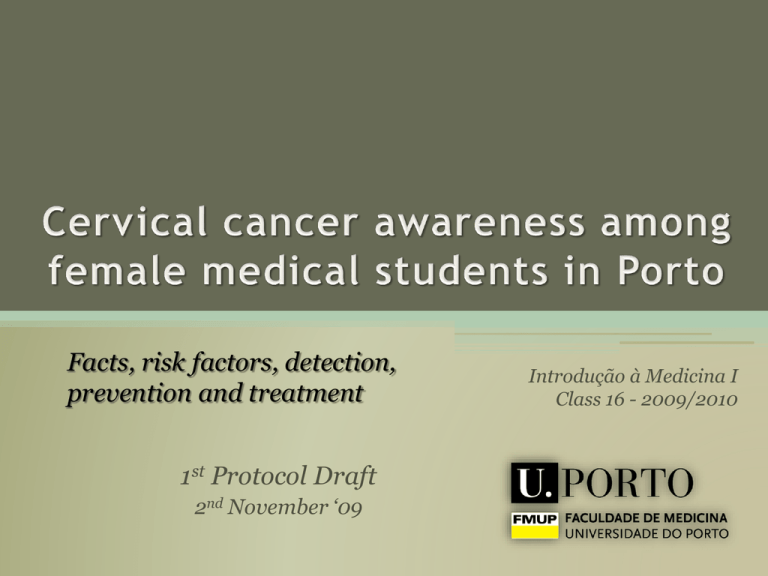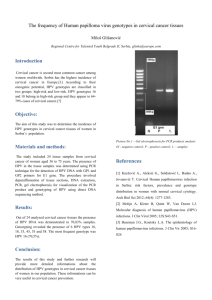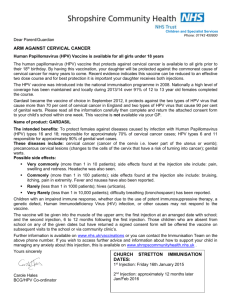Background What is cervical cancer?
advertisement

Facts, risk factors, detection, prevention and treatment 1st Protocol Draft 2nd November ‘09 Introdução à Medicina I Class 16 - 2009/2010 Background What is cervical cancer? • A slow developing malignant cancer that starts in the tissues of the cervix. • Human papillomavirus (HPV) is implicated in more than 99% of these cancers. (Kaplan-Myrth N, 2007, Family Physicians of Canada) HPV as the necessary main cause • Cervical cancer is most often diagnosed in middle-aged women. • 50% cases in the ages 35-55 • 20% cases in ages over 65 • Rarely diagnosed in women younger than 20 years. They’re still at risk! Cervical cancers develop in older women but result from HPV infections that occurred many years earlier Background How common is cervical cancer? • Cervical cancer is the second most common cancer in women worldwide. (Kaplan-Myrth N, 2007, Family Physicians of Canada) • 40 women die daily in Europe because of cervical cancer. (Ferlay J et al, 2004, Globocan 2002) • In 2002, 956 new cases were diagnosed and 378 women died with cervical cancer, in Portugal. (Ferlay J et al, 2004, Globocan 2002) Incidence in Portugal = 13,5 Background What is HPV? • A family of more than 200 DNA viruses. • Some types are responsible for common and plantar warts. • Other types infect the genital tract – these are transmittable through sexual contact: • intercourse; • oral and anal sex; • genital to genital contact. High-risk types – 16 & 18 Low-risk types – 6 & 11 70% of cervical cancers Most genital warts Background Risk cofactors • Some factors increase the HPV’s ability to cause cervical cancer. • Smoking (Anna R. Giuliano, 2002) • Other sexually transmitted infections (STI): • Chlamydia • Herpes virus • HIV virus • Immunodepressive drugs • Others increase the probability of getting infected. • Having many sexual partners • Having a partner with many sexual partners Background How does cervical cancer develop? HPV infection must persist for more than one year Normal Cervix HPV Infection HPV Clearance Infected Cervix Progression Regression CIN Invasion Cancer Background Symptoms and detection • Early cervical cancer is generally asymptomatic. Regular screening in order to detect precancerous lesions • Detection/screening techniques: HPV DNA test (virological) Papanicolaou smear (cytological) Colposcopy Background Prevention • Abstinence is the only completely effective method of HPV infection prevention. • Use of condom reduces the chance of getting infected. • Reduced number of sexual partners. • HPV Vaccination – recommended for women aged 6-26. Quadrivalent vaccine (Gardasil®) Types 6, 11, 16 & 18 Bivalent vaccine (Cervarix®) Types 16 & 18 • Vaccination does not substitute routine cervical cancer screening. (Kaplan-Myrth N, 2007, Family Physicians of Canada) Background Treatment • Treatment depends on the stage and location of the cervical cancer. • Cryosurgery – kills pre-invasive cancers by freezing them • Laser surgery – burning off abnormal tissues and preinvasive cancers • Cone biopsy – excision of a cone-shaped section of the cervix • Hysteroctomy – excision of the uterus and cervix. • Chemotherapy • Radiation Justification and motivation • Although knowledge is not a direct predictor of health behavior, it is a key first step to: • Any health education intervention • Appropriate decision-making • Awareness among female medical students has double importance: • They’re young citizens who belong to the risk group • They’re future health professionals, • We believe there’s potential for better results on prevention of cervical cancer. Research questions and aims • Are female medical students concerned enough about cervical cancer? • Are they conscious of: • Portugal’s situation on cervical cancer? • Availability of vaccine? • Campaigns and recommendations? • We aim to assess students’ knowledge of cervical cancer on several aspects by means of a questionnaire: • HPV connection with cervical cancer • Transmission • Detection and prevention • Also, we want to compare the degree of awareness according to: • Sexual activity • Age • Studies level • Other variables References • Abotchie PN, Shokar NK. (2009) Cervical cancer screening among college students in ghana: knowledge and health beliefs. Int J Gynecol Cancer: Apr;19(3):412-6 • Ayinde OA, Omigbodun AO, Ilesanmi AO (2004). Awareness of cervical cancer, Papanicolaou's smear and its utilisation among female undergraduates in Ibadan. Afr J Reprod Health. Dec;8(3):68-80. • Chelimo C., Wouldes TA (2009) Human papillomavirus knowledge and awareness among undergraduates in healthcare training in New Zealand. N Z Med J.: Oct 9;122(1304):33-45 • Dinas K, Nasioutziki M, Arvanitidou O, Mavromatidis G, Loufopoulos P, Pantazis K, Dovas D, Daniilidis A, Tsampazis N, Zepiridis L, Theodoridis T, Loufopoulos A. (2009) Awareness of human papillomavirus infection, testing and vaccination in midwives and midwifery students in Greece. J Obstet Gynaecol.: Aug;29(6):542-6. • Ferlay J et al, editors, Globocan 2002: Cancer incidence, mortality and prevalence worldwide. IARC Cancer Base No.5 Version 2.0. IARC Press 2004. Lyon •FranceGiuliano AR, Sedjo RL, Roe DJ, Harri R, Baldwi S, Papenfuss MR, Abrahamsen M, Inserra P. (2002). Clearance of oncogenic human papillomavirus (HPV) infection: effect of smoking (United States). Cancer Causes Control. Nov;13(9):839-46. References • Hausen HZ. (2008) Papillomaviruses--to vaccination and beyond. Biochemistry (Mosc). May;73(5):498-503 • Kaplan-Myrth N, Dollin J. (2007). Cervical cancer awareness and HPV prevention in Canada. Can Fam Physician. Apr;53(4):693-6, 697.Leddy MA, Anderson BL, Gall S, Schulkin J. (2009) Obstetriciangynecologists and the HPV vaccine: practice patterns, beliefs, and knowledge. J Pediatr Adolesc Gynecol: Aug;22(4):239-46. • Lim FK. (2002). Management of premalignant lesions of the cervix. Ann Acad Med Singapore. May;31(3):357-64. • Medeiros R, Prazeres H, Pinto D, Macedo-Pinto I, Lacerda M, Lopes C, Cruz E (2005). Characterization of HPV genotype profile in squamous cervical lesions in Portugal, a southern European population at high risk of cervical cancer, Eur J Cancer Prev. 14, 467-71. • Mosavel M, Simon C, Oakar C, Meyer S. (2009) Cervical cancer attitudes and beliefs-a Cape Town community responds on World Cancer Day. J Cancer Educ.;24(2):114-9. • Six L, Leodolter S, Sings HL, Barr E, Haupt R, Joura EA. (2008). Prevalence of human papillomavirus types 6, 11, 16 and 18 in young Austrian women - baseline data of a phase III vaccine trial. Wien Klin Wochenschr. Nov;120(21-22):666-671 References • Sopracordevole F, Cigolot F, Lucia E, Marchesoni D. (2009) Knowledge of HPV-related genital lesions and of anti-HPV vaccination in a sample of women of north-eastern Italy. Minerva Ginecol.: Apr;61(2):81-7 • Teitelman AM, Stringer M, Averbuch T, Witkoski A. (2009) Human papillomavirus, current vaccines, and cervical cancer prevention. J Obstet Gynecol Neonatal Nurs: Jan-Feb;38(1):69-80 • Vera EG, Orozco HH, Soto SS, Aburto EL. (2008) Condom effectiveness to prevent sexually transmitted diseases. Ginecol Obstet Mex. Feb;76(2):88-96.







